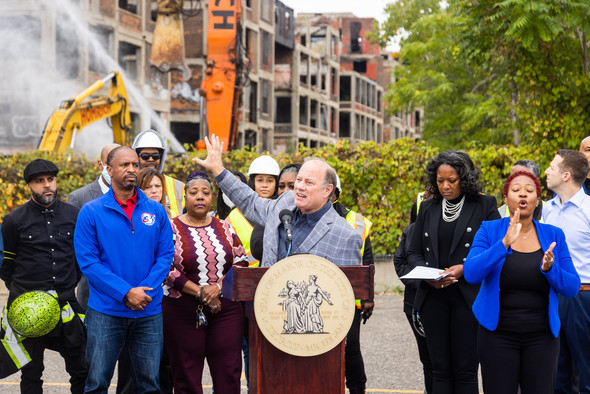City begins demolition of dangerous portion of Packard Plant threatening nearby residents, neighboring business
- Demolition Department overseeing removal of rapidly deteriorating 315,000-square-foot privately-owned portion of the plant
- Crumbling building is connected to and causing damage to occupied Display Group building
- City’s Building Safety Director declared emergency condition in April
- Homrich begins work this week; completion expected in December
In April, the city’s director of building safety declared 6199 Concord an immediate hazard and ordered an emergency demolition. The move came after the complaints of falling masonry from residents along Concord, as well as the Display Group, which is located in a renovated portion of the former plant attached to this particular parcel. Since that time, the city has selected the contractor through the city’s competitive bidding process and worked with them on their plans to safely remove this dangerous structure.
Until earlier this year, the property had been owned by Fernando Palazuelo-controlled Arte Express, which for nearly a decade had owned more than 1 million square feet of the sprawling plant. Palazuelo had accrued more than $1.5M in unpaid taxes, water drainage costs and blight tickets before losing most of his portions of the plant to Wayne County due to the unpaid taxes.
Pre-demolition work at the 315,000-square-foot portion at 6199 Concord began today, including the installation of a barrier to protect The Display Group from falling masonry. This work will begin to safely remove the structure without causing further damage to the Display Group’s building. The contracted cost of the demolition is $1.7 million.
“The deterioration of this building has been a problem for the Display Group and poses an immediate threat to safety, so we will be taking it down as quickly as possible,” said Detroit Demolition Director LaJuan Counts. “Removing this portion of the plant will be a great relief to residents on this block, as well as to the neighboring business.”
During his State of the City Address on March 9, Mayor Mike Duggan said addressing the Packard Plant was a top priority for his administration. Duggan pointed out that the city has undertaken or announced plans to remove or renovate nearly all the city’s most infamous vacant buildings, including the former Michigan Central train station, Lee Plaza, Cadillac Stamping Plant, AMC Headquarters and Fisher Body 21 – and the that the Packard Plant was next on the list. The Packard tops a list of 100 vacant commercial structures Duggan said he plans to have addressed either through redevelopment or demolition during his third term in office.
“The Packard Plant has been our city’s most iconic ruin. It’s been a drain on this neighborhood and it’s time for it to go,” said Mayor Duggan. “As we identify funding we will take down additional portions of the plant until it’s gone and use every legal option at our disposal to hold the previous owner accountable to the judge’s order that compelled him to demolish the plant at his own cost.”
While the vast majority of the plant has been privately owned and eventually will be demolished, the city also is moving forward with demolition of the final portion of the plant it owns that it does not plan to redevelop. Demolition of the southern wings of 1539 E. Grand Boulevard is expected to occur later this year.
“It is unfortunate that the previous plans of the redevelopment did not come to fruition and the lack of action by Fernando Palazuelo has left the building in a dangerous state,” said Council President, Mary Sheffield. “So, I am excited to finally begin the long-awaited demolition of the Packard Plant. I am thrilled that the nearby residents and businesses are one step closer to feeling safer in their community. This is a win that District 5 has been waiting for and I am looking forward to engaging with residents on the next phases of demolition and redevelopment for this community.”
Mayor Duggan stated in his State of the City Address that he plans for the city to preserve the northernmost wing of the property that faces E. Grand Boulevard for redevelopment to retain a portion of the plant’s history in Detroit.

Original source can be found here.





 Alerts Sign-up
Alerts Sign-up